Mojave Air & Space Port Firms Move Towards Space Goals
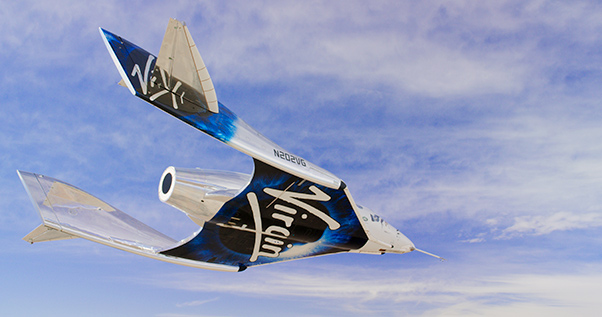
Mojave Air & Space Port aerospace companies are working towards the future of new developments in cutting edge technologies and focusing their goals space. In addition, some are jumping in with the spirit of innovation and a shared mission to develop the solutions needed to protect healthcare workers and save lives during the COVID-19 global pandemic.
“We couldn’t be more proud of our customers’ accomplishments,” said Karina Drees, CEO and General Manager of Mojave Air & Space Port.
Virgin Galactic/The Spaceship Company
Virgin Galactic Holdings, Inc. and its wholly owned subsidiary, The Spaceship Company, announced on May 5, the signing of a Space Act Agreement with NASA to facilitate the development of high speed technologies.
The Space Act Agreement is set to enable and foster collaboration between NASA, Virgin Galactic and The Spaceship Company in order to advance the United States’ efforts to produce technically feasible, high Mach vehicles for potential civil point to point applications.
Virgin Galactic believes that it is able to leverage its robust platform of advanced technologies, significant vertically integrated design, engineering and manufacturing capabilities, and thousands of hours of flight testing to develop additional aerospace applications. Together with its industry partners, Virgin Galactic is seeking to develop a vehicle for the next-generation of safe and efficient high speed air travel, with a focus on customer experience and environmental responsibility.
George Whitesides, CEO of Virgin Galactic Holdings said, “This is the beginning of an important partnership for Virgin Galactic and The Spaceship Company that will support the future development of aviation technology. Virgin Galactic’s unique experience and innovative technology platform will, in partnership with the historic capabilities of NASA and other government agencies, enable the progression of new technical steps that will improve U.S. competitiveness. We see this as an area with tremendous growth potential that we will continue to invest in, alongside our commercial spaceflight operations.”
Fighting COVID-19
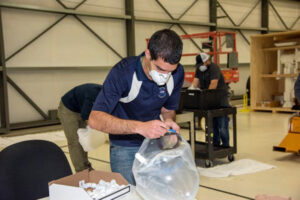
Whitesides recently wrote an article and he gave me permission to share some of it with Aerotech News.
“During the current global crisis, we believe that the space industry has a responsibility to share expertise, knowledge, resources, and ingenuity to aid in the fight against COVID-19, wrote Whitesides. “That’s why, today, we are proud to share that Virgin Galactic is meeting this responsibility head-on through a Space Act Agreement with NASA.”
Employees at Virgin Galactic and The Spaceship Company developed and tested the PPB Hood – a device designed to support patients admitted to hospitals with COVID-19 with portable oxygen-rich pressure chambers, reducing the subsequent need for ventilator intubation,” Whitesides said.
“This Space Act Agreement outlines Virgin Galactic’s commitment to developing innovative solutions to the problems facing healthcare workers on the frontlines. This is our way of ensuring that the best and brightest at Virgin Galactic can support their local communities during this challenging time and provide life-saving solutions for those suffering from COVID-19.” Check out a video on Facebook showing the building of the PPB Hood.
“The work NASA employees are doing in California is one of several examples of how the agency is contributing to the whole-of-government response to coronavirus,” said NASA Administrator Jim Bridenstine. “By channeling the unique skillset of our workforce and engaging private and public partners, we can make a difference in communities such as the Antelope Valley and nationwide.”
A TSC and NASA team are producing 400 PPB Hoods at a specially constructed assembly line at the Final Assembly, Integration and Test Hangar (FAITH) in Mojave.
These hoods are being made available to the Antelope Valley Hospital in Lancaster, California. Special pressure testing was conducted on five prototype hoods, and secured initial authorization for production of the full batch of 400 units of the model approved by doctors. Separately, TSC and NASA are also working on conducting a further test program with Bartlett Community Hospital in Juneau, Alaska.
“I am enormously proud of the contributions of our team, whose dedication in the face of adversity inspires me greatly. With this Space Act Agreement, we chart our next steps forward as a company and as proud members of a global community, committed to doing our best when times are at their hardest. I am confident that we will emerge from this global health crisis stronger and better prepared than ever to set our sights on new horizons and continue in the fulfillment of Virgin Galactic’s mission – overcoming challenges, exploring the unknown, and using space for good,” Whitesides said.
Virgin Orbit – Virgin Orbit’s first launch coming soon
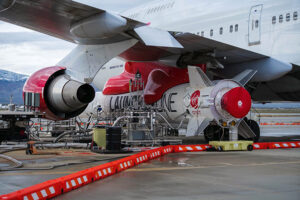
Soon, Virgin Orbit will attempt its first orbital test launch over the Pacific Ocean southwest of Los Angeles, capping a development program for an air-launched small satellite carrier that began in earnest eight years ago.
The small satellite launch company is part of Richard Branson’s Virgin Group. The headquarters and rocket factory are in Long Beach, Calif. Virgin Orbit was founded in 2017 as a spinoff to Virgin Galactic, Branson’s suborbital space tourism company. Virgin Galactic managed the early years of LauncherOne’s development.
Virgin Orbit completed a cryogenic captive carry test of the LauncherOne rocket April 12, demonstrating the performance of the launch vehicle, its Boeing 747 carrier jet, telemetry and tracking systems, and ground teams. During the April 12 captive carry flight, Virgin Orbit’s Boeing 747 carrier jet took off from Mojave Air and Space Port in California’s High Desert and flew off the coast. With pilot Kelly Latimer and three other crewmembers, including launch support engineers, the jumbo jet flew a race track pattern over the Pacific Ocean before lining up for a simulated launch run west of San Nicolas Island, which is owned by the U.S. Navy.
On a real launch, the nearly 30-ton LauncherOne rocket will be released from a pylon under the 747’s left wing during the pull-up maneuver at an altitude of around 35,000 feet. Four seconds after release, the rocket’s kerosene-fueled NewtonThree engine will ignite with 73,500 pounds of thrust to begin climbing into orbit.
Stratolaunch
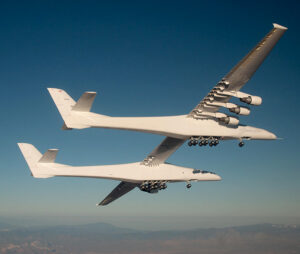
Stratolaunch has some really exciting plans for the huge, six engine carrier aircraft. The company is not only providing launch services, but is now interested in supporting hypersonic vehicles that reach speeds of Mach 5 to Mach 10.
There were questions about the future of the company after the death of the company’s founder and principal funder, Microsoft co-founder Paul Allen. However, in October Stratolaunch announced that Vulcan Inc., Allen’s holding company, had sold the company to an unidentified owner. That new owner was later identified in regulatory filings as Cerebus, a private equity fund, as first reported by GeekWire.
New employees have been recruited to fill positions in this aerospace firm that has a mission statement “to be the world’s leading provider of high-speed flight test services.”
A year ago, the high-altitude launch company Stratolaunch flew the world’s largest aircraft. Now, Stratolaunch has revealed the designs of two hypersonic aircraft plus a reusable space plane that will be launched from its giant Carrier Aircraft launch plane. The company hopes to begin test flights of these vehicles by 2022.
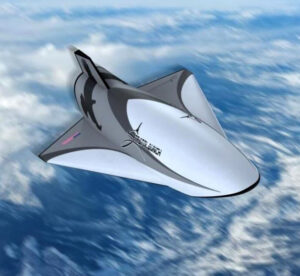
“Our hypersonic testbeds will serve as a catalyst in sparking a renaissance in hypersonic technologies for our government, the commercial sector, and academia,” said W. Jean Floyd, Stratolaunch’s CEO, on the company’s website.
The two new hypersonic planes are called Talon-A and Talon-Z, while the space plane is dubbed Black Ice.
Talon-A is a flexible, high-speed testbed built for hypersonic research, experiments, and enabling operational missions. The vehicle will be 8.5 meters long with a wingspan of 3.4 meters and a total mass of approximately 2.7 tons at launch. It will be dropped aloft by its mothership, the giant carrier aircraft.
“We believe that innovative flight research and testing programs are key to enabling our nation to develop emerging hypersonic technologies into operational systems. Stratolaunch designs, manufactures, and launches aerospace vehicles and technologies to fulfill several important national needs, including the need for reliable, routine access to space and the need
to significantly advance the nation’s ability to design and operate hypersonic vehicles. Developing hypersonic technologies is one of our country’s most important national priority programs,” said Stephen Corda, chief technology officer on the company’s website.
National Test Pilot School
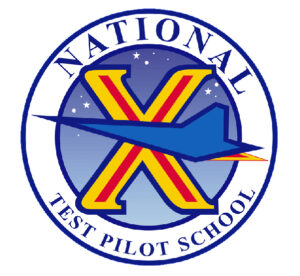
On Feb. 26, 2020, the National Test Pilot School made flight test education history by becoming the first and only test pilot school in the world to achieve Institutional Accreditation.
In addition to ABET Accreditation for their Master of Science in Flight Test Engineering Degree, NTPS is now accredited as a Graduate School by the WASC Senior College and University Commission; a U.S. Department of Education recognized accreditation agency.
“We are an innovative leader in total flight test training and research. The National Test Pilot School has been serving the worldwide flight test community since 1981 and has trained thousands of Test Pilots and Flight Test Engineers through its diverse course offerings,” said Dr. Allen Peterson, NTPS President and CEO.
Masten Space Systems
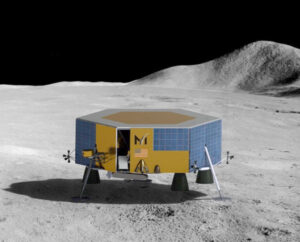
NASA has chosen a new lunar surface delivery partner from its list of Commercial Lunar Payload Services vendors to actually transport materials on its behalf – Mojave’s Masten Space Systems, which is being tapped by the agency to take eight payloads, including non-science and tech instruments, to the Moon’s South Pole in 2022.
Masten’s contract is a $75.9 million award that specifies end-to-end delivery of the payloads, as well as their integration with the company’sm XL-1 lander. They’re also required to land on the Moon and operate for at least 12 days post-landing.
“Masten is thrilled to have NASA as our anchor customer on this mission,” said CEO Sean Mahoney. “As we, like the rest of the world, work to keep our employees and families safe in these trying times, we’re glad to see America’s return to the Moon and space commerce moving forward.”
“Masten’s XL-1 lunar lander is built on over a decade of experience in vertical takeoff and vertical landing technology with a focus on
reusability,” explained Founder and CTO David Masten. “We’re grateful for all the partners and customers who have worked with our team to perform hundreds of successful rocket landings. This experience has helped us develop the enabling technology of entry, descent and landing that will ensure precise and safe landings on other celestial bodies.”
